Anyone who appreciates good beer understands Belgium’s reputation for excellent brewing. As well, anyone who know me likely realizes my feelings towards the brewing arts. The ability to sample a large contingent of Belgian beers conveniently and inexpensively was definitely a bonus to our several visits.
Each beer has its own distinctive glass and anyone can start a collection. Most large supermarkets like Delhaize include a selection of them in the beer aisle. Belgian brewers want consumers to be able to appreciate their product in a proper glass that will accentuate its best attributes and enhance the overall experience. So glasses are pretty easy to find. I managed to collect several on trips to Belgium.
You can also view an interactive map of the breweries and brewpubs I have visited.
Belgian Brewers’ Guild
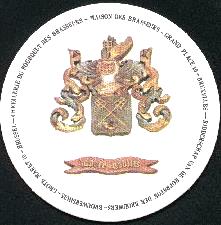
The Brewers’ Guild runs a museum in the basement of their building on the Grand’ Place in Brussels (map). At the time of our visit it cost something like 100 Belgian Francs in the days before the Euro. That equated to something like three bucks. Entry included a tour and a free beer at the end. The exhibits outlined the brewing process, mapped brewery locations, and provided several interactive displays. Our Belgian friends particularly liked the museum because it included free toilet facilities, a rare thing around here.
The coaster above came with the free beer. Very roughly translated it says something like: The knighthood of brewers — the guild house of brewers, 10 Grand’ Place, Brussels. Or in its original languages, “CHEVALERIE DU FOURQUET DES BRASSEURS – MAISON DES BRASSEURS – GRAND’ PLACE 10 – BRUXELLES – RIDDERSCHAP VAN DE ROERSTOK DER BROUWERS – BROUWERSHUIS – GROTE MARKT 10 – BRUSSEL”
Abbaye de Leffe
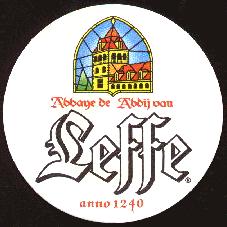
I got the Leffe coaster in Dinant where we relaxed after a full day of touring. We sat on an outdoor patio along the Meuse River on a sunny late-Summer afternoon enjoying the breeze, and considered ourselves truly fortunate.
Abbaye de Leffe, now part of AB InBev, began its life as an abbey brewery in Dinant way back in 1240 (map). This rich heritage comes through on the coaster.
Brasserie Belle-Vue
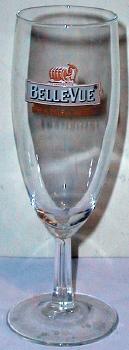
Belle-vue’s framboise lambic comes in a delightfully fluted glass reminiscent of something for champagne. Framboise translates to “raspberry.” True lambic beers ferment spontaneously only in one small geographic area near Brussels (map). However, this highly-commercialized version of lambic (in this case an AB InBev product) differs dramatically from what would be experienced at the very traditional Cantillon Brewery and Museum.
The glass includes the Belle-Vue logo, with a man stooping over to fill a pail of beer from a huge wooden barrel. Also it included the mark “PH. VANDENSTOCK”
Chimay
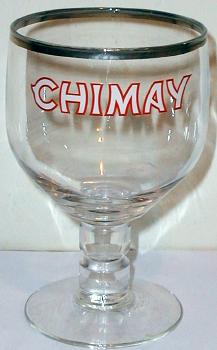
This may be one of the best known Belgian brewery glasses, and certainly one of those at the forefront of the increasing recognition of Belgian beers across the world. Behold the trademark Chimay goblet. I particularly like the heft of the base. It feels quite substantial when raising it up. The two ringed slots along the stem provide a great grip, too.
Chimay, of course, remains one of the few traditional Trappist breweries. Cistercian Trappist monks of the Abbey of Notre-Dame de Scourmont began making beer here in 1850 (map). This preserves a monastic tradition dating back to the middle ages.
Delirium Tremens
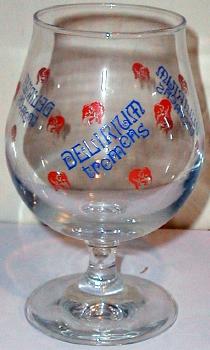
Brouwerij Huyghe brews this Belgian Strong Ale (map). “Delirium Tremens” derives from Latin for “shaking delirium” or what some colloquially called the DT’s. It can happen to a severe alcoholic during withdrawal. A pink elephant serves as a somewhat stereotypical DT hallucination. Those serve as a symbol of the beer. They appear prominently on all of their packaging including this snifter-style goblet. The elephant even wears a Santa hat on their Christmas beer!
It seems a little counter-intuitive to name a beer after a serious medical condition. Why poke fun at the abuse of your product? Nonetheless this forms part of the quirky Belgian sense of humor that I so much enjoy. This same sense of irreverence extends to Belgian brewing and results in so many delightful and unanticipated styles and variations.
Duvel
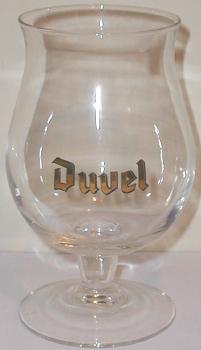
The name of the beer translates from Flemish into English as “The Devil” for this strong, golden pale ale. Duvel should be served in a tulip-shaped goblet glass. This flagship beer of Brouwerij Duvel Moortgat (map) ships throughout the world to more than 40 countries. In another interesting note, Duvel Moortgat took over the American brewery Ommegang as a way to further branch out to beer lovers in the United States.
Verboden Vrucht / Le Fruit Defendu
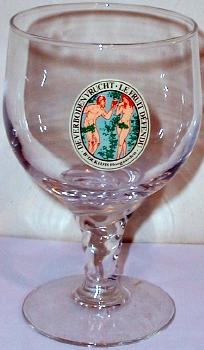
Translating to “Forbidden Fruit,” this specialty dark beer from Hoegaarden (map) also belongs to the AB InBev family.
The beer and its goblet feature an Adam and Eve theme. However, in this case Adam tempts Eve with a beer instead of an apple. Vegetation covers the couple in strategic places to preserve their decency… well, for the most part anyway. Some might consider the Eve portrayal a little risque.
Grimbergen
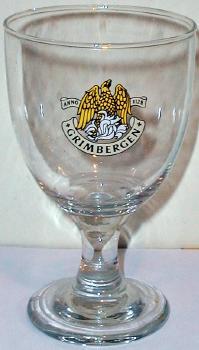
Grimbergen should be drunk from a true goblet. The glass features the Grimbergen logo with a rising phoenix and the notation of “ANNO 1128. ” It recognizes the founding of an abbey by St. Norbert of the Norbertine order in the Brabant town of Grimbergen (map).
Many Belgian breweries issue Christmas Sets. Indeed, I got this glass as part of such a set. The glass plus a bottle of each of their beers came in an attractive wooden box that now houses a portion of my coaster collection.
Today Grimbergen forms part of the Alken Maes brewery group (Brouwerijen Alken-Maes Brasseries).
Kasteel
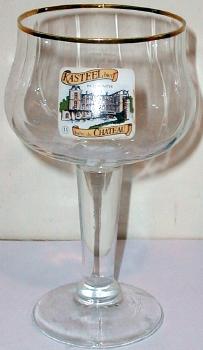
Kasteel uses a very interestingly shaped goblet, with the volume contained in a wide vessel skewed towards the upper vertical portion of the glass. Brouwerij Van Honsebrouck produces Kasteel (map). It also owns the castle in Ingelmunster after which the beer is named and the logo portrays.
I remember a number of years ago when I first came across Kasteel Bruin while in Belgium, and carried a couple of bottles all over Europe to get them home. Only then did I discover upon my return that they had started exporting. Now I can obtain Kasteel anytime I like, for which I’m grateful.
La Chouffe
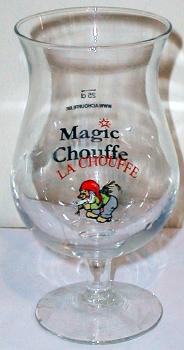
La Chouffe represents a strong golden ale style, the flagship beer of Brasserie d’Achouffe (map). The little gnome character on this tulip-shaped goblet appears often on their packaging. However, what is a little more unusual about this glass is that the “Magic Choufee” lettering is actually printed in reverse on the back side. It comes into view through the front of the glass as it empties.
In September 2006 Duvel Moortgat bought Brasserie d’Achouffe
Orval
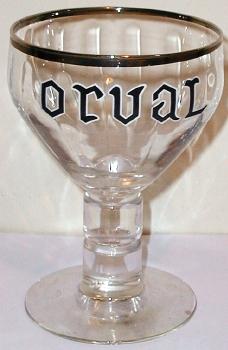
The Orval goblet feels rather substantial, with an interesting set of ridges crafted vertically into the bowl. This qualifies as a true Trappist Ale associated with a Cistercian monastery (map).
Today laypeople work in the brewery but it still aligns very closely with the abbey. Profits go to community and charitable causes. Orval pours light in color and includes rather distinct flavors due to the use of a locally wild Brettanomyces yeast.
Scaldis
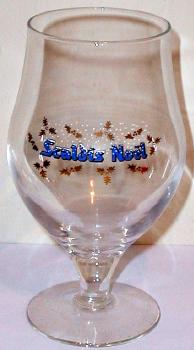
The Belgian beer Bush, produced by Brasserie Dubuisson Frères (map), sometimes bears the Scaldis label for export. Their Christmas beer should be served in a bulbed goblet. Note the snowflakes and holly leaves.

Leave a Reply